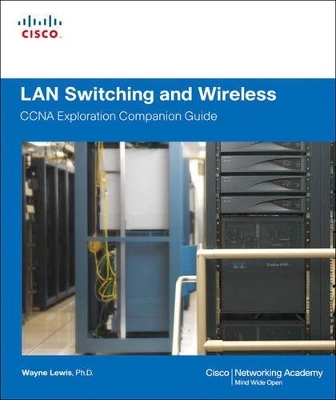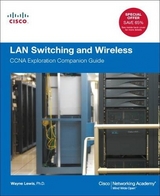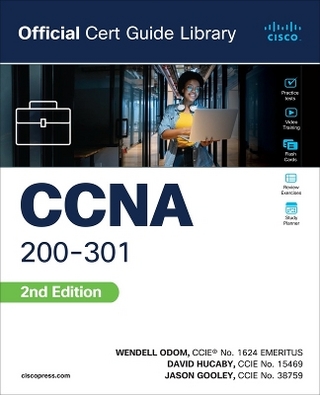
LAN Switching and Wireless, CCNA Exploration Companion Guide
Cisco Press
978-1-58713-207-0 (ISBN)
- Titel erscheint in neuer Auflage
- Artikel merken
Wayne Lewis, Ph.D.
LAN Switching and Wireless, CCNA Exploration Companion Guide is the official supplemental textbook for the LAN Switching and Wireless course in the Cisco Networking Academy CCNA® Exploration curriculum version 4. This course provides a comprehensive approach to learning the technologies and protocols needed to design and implement a converged switched network. The Companion Guide, written and edited by a Networking Academy instructor, is designed as a portable desk reference to use anytime, anywhere. The book’s features reinforce the material in the course to help you focus on important concepts and organize your study time for exams.
New and improved features help you study and succeed in this course:
Chapter objectives: Review core concepts by answering the questions listed at the beginning of each chapter.
Key terms: Refer to the updated lists of networking vocabulary introduced and turn to the highlighted terms in context in each chapter.
Glossary: Consult the all-new comprehensive glossary with more than 190 terms.
Check Your Understanding questions and answer key: Evaluate your readiness with the updated end-of-chapter questions that match the style of questions you see on the online course quizzes. The answer key explains each answer.
Challenge questions and activities: Strive to ace more challenging review questions and activities designed to prepare you for the complex styles of questions you might see on the CCNA exam. The answer key explains each answer.
Wayne Lewis is the Cisco Academy Manager for the Pacific Center for Advanced Technology Training (PCATT), based at Honolulu Community College.
How To: Look for this icon to study the steps that you need to learn to perform certain tasks.
Packet Tracer Activities: Explore networking concepts in activities interspersed throughout some chapters using Packet Tracer v4.1 developed by Cisco. The files for these activities are on the accompanying CD-ROM.
Also available for the LAN Switching and Wireless course:
LAN Switching and Wireless, CCNA Exploration Labs and Study Guide
ISBN-10: 1-58713-202-8
ISBN-13: 978-1-58713-202-5
Companion CD-ROM
The CD-ROM provides many useful tools and information to support your education:
Packet Tracer Activity exercise files
A Guide to Using a Networker’s Journal booklet
Taking Notes: A .txt file of the chapter objectives
More IT Career Information
Tips on Lifelong Learning in Networking
This book is part of the Cisco Networking Academy Series from Cisco Press®. Books in this series support and complement the Cisco Networking online curriculum.
Wayne Lewis is the Cisco Academy Manager for the Pacific Center for Advanced Technology Training (PCATT), based at Honolulu Community College (HonCC), and the Legal Main Contact for the CCNA/CCNP/Network Security Cisco Academy Training Center at PCATT/HonCC. Since 1998, Wayne has taught routing and switching, wide area networking, network troubleshooting, network security, wireless networking, IP telephony, and quality of service to instructors from universities, colleges, and high schools in Australia, Canada, Mexico, Central America, South America, United States, American Samoa, Guam, China, Hong Kong, Taiwan, Indonesia, Singapore, Korea, Japan, Italy, Germany, Netherlands, Sweden, Poland, Hungary, and Great Britain, both onsite and at PCATT/HonCC. Cisco has sent Wayne to several countries to conduct inaugural Networking Academy teacher-training sessions to certify the initial cohorts of instructors and kick off the training centers for these countries. Before teaching networking, Wayne began teaching at age 20 at Wichita State University, followed by the University of Hawaii and HonCC. In 1992, Wayne received a Ph.D. in math, specializing in finite rank torsion-free modules over a Dedekind domain; he now works on algebraic number theory research in his spare time. Wayne works as a contractor for Cisco , performing project management for the development of network security, CCNA, and CCNP curriculum. He and his wife, Leslie, also run a network consulting company. Wayne enjoys surfing the South Shore of Oahu in the summer and surfing big waves on the North Shore in the winter.
Chapter 1 LAN Design 1
Objectives 1
Key Terms 1
Switched LAN Architecture 2
The Hierarchical Network Model 2
Access Layer 2
Distribution Layer 3
Core Layer 3
A Hierarchical Network in a Medium-Sized Business 4
Benefits of a Hierarchical Network 4
Principles of Hierarchical Network Design 6
Network Diameter 7
Bandwidth Aggregation 8
Redundancy 9
What Is a Converged Network? 10
Legacy Equipment 10
Advanced Technology 11
New Options 12
Separate Voice, Video, and Data Networks 13
Matching Switches to Specific LAN Functions 15
Considerations for Hierarchical Network Switches 15
Traffic Flow Analysis 15
User Community Analysis 17
Data Stores and Data Servers Analysis 19
Topology Diagrams 20
Switch Features 22
Switch Form Factors 22
Switch Performance 24
Power over Ethernet and Layer 3 Functionality 26
Switch Features in a Hierarchical Network 28
Access Layer Switch Features 28
Distribution Layer Switch Features 30
Core Layer Switch Features 31
Switches for Small and Medium Sized Business (SMB) 33
Catalyst Express 500 33
Catalyst 2960 34
Catalyst 3560 35
Catalyst 3750 36
Catalyst 4500 36
Catalyst 4900 37
Catalyst 6500 38
Comparing Switches 39
Summary 40
Labs 40
Check Your Understanding 41
Challenge Questions and Activities 44
Chapter 2 Basic Switch Concepts and Configuration 45
Objectives 45
Key Terms 45
Introduction to Ethernet/802.3 LANs 46
Key Elements of Ethernet/802.3 Networks 46
CSMA/CD 46
Ethernet Communications 47
Duplex Settings 49
Switch Port Settings 50
Switch MAC Address Table 51
Design Considerations for Ethernet/802.3 Networks 52
Bandwidth and Throughput 52
Collision Domains 53
Broadcast Domains 54
Network Latency 54
Network Congestion 55
LAN Segmentation 55
LAN Design Considerations 56
Forwarding Frames Using a Switch 58
Switch Forwarding Methods 59
Symmetric and Asymmetric Switching 60
Memory Buffering 60
Layer 2 and Layer 3 Switching 62
Switch Management Configuration 63
Navigating Command-Line Interface Modes 63
GUI-Based Alternatives to the CLI 65
Using the Help Facility 68
Accessing the Command History 70
Switch Boot Sequence 71
Prepare to Configure the Switch 72
Basic Switch Configuration 72
Management Interface 73
Default Gateway 74
Duplex and Speed 75
HTTP Access 76
MAC Address Table Management 77
Verifying Switch Configuration 78
Basic Switch Management 80
Backing Up and Restoring Switch Configuration Files 80
Using a TFTP Server with Switch Configuration Files 82
Clearing Switch Configuration Information 84
Configuring Switch Security 85
Configuring Password Options 85
Securing Console Access 85
Securing Virtual Terminal Access 87
Securing Privileged EXEC Access 88
Encrypting Switch Passwords 89
Password Recovery 90
Login Banners 92
Configure Telnet and SSH 93
Configuring Telnet 93
Configuring SSH 94
Common Security Attacks 96
MAC Address Flooding 96
Spoofing Attacks 100
CDP Attacks 101
Telnet Attacks 102
Security Tools 103
Configuring Port Security 105
Securing Unused Ports 110
Summary 111
Labs 111
Check Your Understanding 112
Challenge Questions and Activities 117
Chapter 3 VLANs 121
Objectives 121
Key Terms 121
Introducing VLANs 122
Defining VLANs 122
Benefits of VLANs 124
VLAN ID Ranges 126
Types of VLANs 126
Voice VLANs 131
Network Application Traffic Types 133
Switch Port Membership Modes 136
Controlling Broadcast Domains with VLANs 138
VLAN Trunking 143
VLAN Trunks 144
IEEE 802.1Q Frame Tagging 145
Native VLANs 147
Trunking Operation 148
Trunking Modes 149
Configure VLANs and Trunks 151
Configure a VLAN 152
Managing VLANs 155
Managing VLAN Memberships 158
Configure a Trunk 160
Troubleshooting VLANs and Trunks 164
Common Problems with Trunks 165
A Common Problem with VLAN Configurations 171
Summary 173
Labs 173
Check Your Understanding 174
Challenge Questions and Activities 178
Chapter 4 VTP 181
Objectives 181
Key Terms 181
VTP Concepts 182
What Is VTP? 182
Benefits of VTP 184
VTP Components 184
VTP Operation 186
Default VTP Configuration 186
VTP Domains 188
VTP Advertising 190
VTP Configuration Revision Number 192
VTP Advertisement Types 193
VTP Modes 197
VTP Server-to-Client Behavior 198
VTP Server-to-Transparent-to-Client Behavior 199
VTP Pruning 201
VTP Pruning in Action 202
Configure VTP 204
Configuring VTP 204
Steps to Configuring VTP 206
Troubleshooting VTP Configurations 212
Incompatible VTP Versions 212
VTP Password Issues 212
Incorrect VTP Domain Name 213
All Switches Set to VTP Client Mode 214
VTP Troubleshooting Example 215
Managing VLANs on a VTP Server 217
Summary 219
Labs 219
Check Your Understanding 220
Challenge Questions and Activities 224
Chapter 5 STP 227
Objectives 227
Key Terms 227
Redundant Layer 2 Topologies 229
Redundancy 229
Issues with Redundancy 234
Broadcast Storms 238
Duplicate Unicast Frames 240
Real-World Redundancy Issues 241
Loops in the Wiring Closet 242
Loops in Cubicles 243
Introduction to STP 244
Spanning-Tree Algorithm (STA) 244
STP Topology 245
Port Types in the Spanning-Tree Algorithm 247
Root Bridge 248
Best Paths 249
STP BPDU 252
BPDU Process 253
Bridge ID 258
Configure and Verify the BID 261
Port Roles 263
Configure Port Priority 265
Port Role Decisions 266
STP Port States and BPDU Timers 268
Cisco PortFast 271
STP Convergence 273
Step 1. Elect a Root Bridge 273
Verify Root Bridge Election 274
Step 2. Elect Root Ports 276
Verify Root Port Election 278
Step 3. Elect Designated and Nondesignated Ports 279
Verify Designated and Nondesignated Port Election 283
STP Topology Change 285
PVST+, RSTP, and Rapid PVST+ 286
Cisco and IEEE STP Variants 287
Per-VLAN Spanning-Tree (PVST) Overview 287
Per-VLAN Spanning-Tree Plus (PVST+) Overview 287
Rapid Spanning-Tree Protocol (RSTP) Overview 288
Multiple Spanning-Tree Protocol (MSTP) Overview 288
PVST+ 288
Configure PVST+ 291
RSTP 294
RSTP BPDU 295
Edge Ports 296
Link Types 297
RSTP Port States and Port Roles 298
RSTP Proposal and Agreement Process 301
Configuring Rapid PVST+ 309
Design STP for Trouble Avoidance 312
Minimize the Number of Blocked Ports 313
Use Layer 3 Switching 314
Keep STP Even if It Is Unnecessary 316
Keep Traffic off of the Management VLAN 316
Troubleshoot STP Operation 316
PortFast Configuration Error 317
Network Diameter Issues 318
Summary 320
Labs 320
Check Your Understanding 321
Challenge Questions and Activities 327
Chapter 6 Inter-VLAN Routing 331
Objectives 331
Key Terms 331
Inter-VLAN Routing 332
Introducing Inter-VLAN Routing 332
One-Router-Interface-per-VLAN 332
Router-on-a-Stick 334
Layer 3 Switch 336
Interfaces and Subinterfaces 337
One-Router-Interface-per-VLAN 338
Router-on-a-Stick 341
Considerations for Inter-VLAN Routing Methods 345
Configuring Inter-VLAN Routing 347
Configure Inter-VLAN Routing 347
Configure Router-on-a-Stick Inter-VLAN Routing 351
Troubleshooting Inter-VLAN Routing 356
Switch Configuration Issues 356
Switch Cisco IOS Commands for Troubleshooting 359
Router Configuration Issues 360
Router Cisco IOS Commands for Troubleshooting 361
IP Addressing Issues 362
IP Addressing Cisco IOS Verification Commands 364
Summary 366
Labs 366
Check Your Understanding 367
Challenge Questions and Activities 373
Chapter 7 Basic Wireless Concepts and Configuration 377
Objectives 377
Key Terms 377
The Wireless LAN 379
Why Use Wireless? 379
Wireless LANs 380
Comparing a WLAN to a LAN 381
Wireless LAN Components 383
Wireless LAN Standards 383
Wi-Fi Certification 386
Wireless Infrastructure Components 387
Wireless NICs 387
Wireless Access Points 388
Wireless Routers 390
Wireless Operation 391
Configurable Wireless Parameters 391
Wireless Topologies 393
Wireless Association 396
Planning the Wireless LAN 399
Wireless LAN Security 402
Threats to Wireless Security 402
Rogue Access Points 402
Man-in-the-Middle Attacks 403
Denial of Service 404
Wireless Security Protocols 405
Authenticating the Wireless LAN 407
Wireless Encryption 408
Controlling Access to the WLAN 409
Configure Wireless LAN Access 410
Configuring the Wireless Access Point 410
Configuring Basic Wireless Settings 413
Configuring Wireless Security 415
Configuring a Wireless NIC 418
Scan for SSIDs 418
Select the Wireless Security Protocol 420
Verify Connectivity to the WLAN 423
Troubleshooting Simple WLAN Problems 424
A Systematic Approach to WLAN Troubleshooting 424
Solve Access Point Radio and Firmware Issues 426
Channel Settings 426
RF Interference 429
Access Point Placement 431
Authentication and Encryption 434
Summary 436
Labs 436
Check Your Understanding 437
Challenge Questions and Activities 441
Appendix Check Your Understanding and Challenge Questions
Answer Key 445
Glossary 461
| Erscheint lt. Verlag | 8.5.2008 |
|---|---|
| Reihe/Serie | Cisco Networking Academy - Mind Wide Open |
| Verlagsort | Indianapolis |
| Sprache | englisch |
| Maße | 241 x 204 mm |
| Gewicht | 1114 g |
| Themenwelt | Mathematik / Informatik ► Informatik ► Netzwerke |
| Informatik ► Weitere Themen ► Zertifizierung | |
| Schlagworte | CCNA (Cisco Certified Network Associate) • CNAP (Cisco Networking Academy Program) |
| ISBN-10 | 1-58713-207-9 / 1587132079 |
| ISBN-13 | 978-1-58713-207-0 / 9781587132070 |
| Zustand | Neuware |
| Haben Sie eine Frage zum Produkt? |
aus dem Bereich



